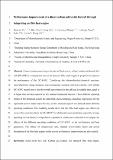Files in this item
Performance improvement of a direct carbon solid oxide fuel cell through integrating an Otto heat engine
Item metadata
| dc.contributor.author | Xu, Haoran | |
| dc.contributor.author | Chen, Bin | |
| dc.contributor.author | Tan, Peng | |
| dc.contributor.author | Zhang, Houcheng | |
| dc.contributor.author | Yuan, Jinliang | |
| dc.contributor.author | Irvine, John T. S. | |
| dc.contributor.author | Ni, Meng | |
| dc.date.accessioned | 2019-04-06T23:38:48Z | |
| dc.date.available | 2019-04-06T23:38:48Z | |
| dc.date.issued | 2018-06-01 | |
| dc.identifier | 252771488 | |
| dc.identifier | c5e58739-9643-4a90-abd1-0e347ab33a2a | |
| dc.identifier | 85044974143 | |
| dc.identifier | 000433269200062 | |
| dc.identifier.citation | Xu , H , Chen , B , Tan , P , Zhang , H , Yuan , J , Irvine , J T S & Ni , M 2018 , ' Performance improvement of a direct carbon solid oxide fuel cell through integrating an Otto heat engine ' , Energy Conversion and Management , vol. 165 , pp. 761-770 . https://doi.org/10.1016/j.enconman.2018.04.008 | en |
| dc.identifier.issn | 0196-8904 | |
| dc.identifier.other | RIS: urn:4F06EBD2FF546FCF41EC5530DB7BEB46 | |
| dc.identifier.other | ORCID: /0000-0002-8394-3359/work/68280795 | |
| dc.identifier.uri | https://hdl.handle.net/10023/17472 | |
| dc.description | This research is supported by the Natural Science Foundation of Zhejiang Province (Grant No. LQ14E060001), National Natural Science Foundation of China (Grant No. 51406091), a grant (PolyU 152127/14E) from Research Grant Council, University Grants Committee, Hong Kong SAR, a grant from Environment and Conservation Fund (ECF 54/2015), Hong Kong SAR, and the K. C. Wong Magna Fund in Ningbo University. | en |
| dc.description.abstract | A novel system consisting of an external heat source, a direct carbon solid oxide fuel cell (DC-SOFC), a regenerator and an air standard Otto cycle engine is proposed to improve the performance of the DC-SOFC. Considering the electrochemical/chemical reactions, ionic/electronic charge transport, mass/momentum transport and heat transfer, a 2D tubular DC-SOFC model shows that the overall heat released in the cell can be smaller than, equal to or larger than the heat required by the internal Boudouard reaction. Three different operating modes of the proposed system are identified, and accordingly, analytical expressions for the equivalent power output and efficiency of the proposed system are derived under different operating conditions. The modeling results show that the Otto heat engine can effectively recover the waste heat from the DC-SOFC for additional power production especially at large operating current density. Comprehensive parametric studies are conducted to investigate the effects of the different operating conditions of DC-SOFC on its performance and heat generation. The effects of compression ratio, internal irreversibility factor and power dissipation of the Otto heat engine on the system performance improvement are also studied. | |
| dc.format.extent | 10 | |
| dc.format.extent | 2263333 | |
| dc.language.iso | eng | |
| dc.relation.ispartof | Energy Conversion and Management | en |
| dc.subject | Solid oxide fuel cell | en |
| dc.subject | Carbon gasification | en |
| dc.subject | Air standard Otto heat engine | en |
| dc.subject | Performance improvement | en |
| dc.subject | Parametric study | en |
| dc.subject | QD Chemistry | en |
| dc.subject | NDAS | en |
| dc.subject.lcc | QD | en |
| dc.title | Performance improvement of a direct carbon solid oxide fuel cell through integrating an Otto heat engine | en |
| dc.type | Journal article | en |
| dc.contributor.institution | University of St Andrews. School of Chemistry | en |
| dc.contributor.institution | University of St Andrews. EaSTCHEM | en |
| dc.identifier.doi | 10.1016/j.enconman.2018.04.008 | |
| dc.description.status | Peer reviewed | en |
| dc.date.embargoedUntil | 2019-04-07 |
This item appears in the following Collection(s)
Items in the St Andrews Research Repository are protected by copyright, with all rights reserved, unless otherwise indicated.

